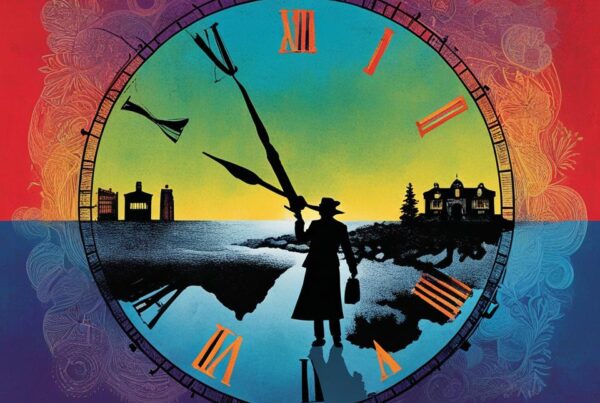Welcome to our comprehensive audiobook review of “The Art of Fielding” by acclaimed author Chad Harbach. In this review, we will explore the narrative prowess and character depth in this literary masterpiece. We will evaluate not only the compelling storyline, but also the audiobook narration and performance, as well as the critical and reader receptions. So stay tuned for an in-depth analysis of this unforgettable book.
The Storyline and Plot
“The Art of Fielding” by Chad Harbach follows the journey of Henry Skrimshander, a talented shortstop with dreams of playing Major League Baseball. The novel is set in the fictional Westish College, where Henry is recruited by its president, Guert Affenlight, to play for their baseball team.
The plot delves into the lives of the various characters, exploring their ambitions, fears, and relationships. Throughout the story, we witness the characters struggle with personal and professional obstacles, including injury, unrequited love, and academic pressure.
The narrative is driven by the recurring themes of identity, self-discovery, and the pursuit of excellence. As the characters navigate their personal and academic lives, they are forced to confront their own insecurities and limitations, ultimately leading to personal growth and transformation.
The plot is expertly crafted, with a seamless flow and a satisfying conclusion. Harbach’s use of literary devices, including foreshadowing and symbolism, adds depth and complexity to the storyline.
Key Themes:
- The Pursuit of Perfection: The characters in “The Art of Fielding” are driven by their desire for excellence, both on the baseball field and in their personal lives. Their pursuit of perfection often leads to personal struggle and self-doubt.
- Identity: The novel explores the characters’ search for identity and their struggles with self-discovery. Each of the characters grapples with defining themselves, both independently and in relation to others.
- Love and Relationships: The novel explores various types of relationships, from romantic to platonic, and the impact they have on individual growth and development.
Character Development
“The Art of Fielding” is a novel that excels in character development, presenting a range of personalities with diverse motivations and objectives. Throughout the story, readers witness the growth and transformation of these characters, resulting in a rich and nuanced narrative.
At the center of the story is Henry Skrimshander, the promising young baseball player whose talent propels him to stardom. As the story progresses, readers discover the complex personality of Henry, whose weaknesses threaten to shatter his career and personal life. His journey is one of self-discovery, overcoming personal hurdles, and becoming a better person – both on and off the field.
Other notable characters include Mike Schwartz, Henry’s mentor, and friend, who takes on the role of guiding Henry towards his true potential. The character development of Mike Schwartz is instrumental in presenting the theme of the significance of friendship. Furthermore, his transition from an authoritative figure with a hot temper to a more balanced character demonstrates the theme of personal growth.
The female characters in “The Art of Fielding” also undergo significant development, challenging traditional gender roles in literature. Pella Affenlight, the college president’s daughter, and Guert Affenlight’s lover, emerges as a complex and multi-dimensional character, with her own ambitions and obstacles to overcome.
The character development in “The Art of Fielding” elevates the story beyond a simple sports narrative. Each character is presented as an individual, with their own aspirations, complexities, and path to self-discovery. Chad Harbach’s writing style and pacing allow readers to fully invest in these characters, resulting in an emotional, engaging, and rewarding reading experience.
Themes and Symbolism
In “The Art of Fielding”, Chad Harbach masterfully weaves several underlying themes into the story, enriching it with literary symbolism and visual metaphors that add to its depth and complexity. One of the primary themes explored in the novel is the pursuit of perfection, as seen through the lens of baseball, a game that requires precision, strategy, and skill. This theme is reflected in the character of Henry Skrimshander, a talented young baseball player who strives for excellence on the field but faces personal and emotional challenges off it.
Another key theme in the novel is the impact of mentorship and guidance, as embodied by the character of Mike Schwartz, the captain of the Westish College baseball team, who takes Henry under his wing and helps him hone his skills. This theme is further explored through the relationships between other characters, such as Pella, Owen, and Guert Affenlight, demonstrating how mentorship can have far-reaching effects on personal growth and development.
Symbolism is also a prevalent element in “The Art of Fielding”, imbuing the story with depth and meaning. One notable example is the white whale that appears throughout the novel, a nod to Herman Melville’s “Moby Dick”. This symbolism comes to represent both opportunity and danger, reflecting the pursuit of success and the possibility of failure in equal measure.
Writing Style and Language
Chad Harbach’s writing style in “The Art of Fielding” is a masterpiece of vivid and expressive language. He uses literary techniques such as imagery and symbolism to create a rich and immersive reading experience. The dialogue is sharp and realistic, giving depth to the characters and driving the story forward.
Harbach’s prose is crafted with precision, allowing the story’s themes to shine through naturally and elegantly. Throughout the novel, the language reflects the growing tension and emotional depth of the story, creating a truly memorable literary experience.

Imagery and Symbolism
One of Harbach’s greatest strengths as a writer is his ability to use imagery and symbolism to enhance the story’s impact. His descriptions of the baseball field are particularly noteworthy, capturing the thrill and intensity of the game while painting a vivid picture of the setting.
Furthermore, the symbolism throughout the novel is masterfully executed. From the recurring motif of the whale to the use of the Greek myth of Daedalus and Icarus, Harbach weaves a complex tapestry of meaning and allusion that elevates “The Art of Fielding” to the realm of literary art.
Prose and Dialogue
Harbach’s prose is both elegant and accessible, flowing smoothly and gracefully from page to page. He avoids pretension and instead focuses on creating a natural and immersive reading experience that draws the reader into the story.
The dialogue is similarly well-crafted, with each character given a unique voice and personality that shines through in their speech. Each conversation feels authentic and impactful, playing a key role in the development of both the characters and the story as a whole.
Impact on Reading Experience
Overall, Harbach’s writing style and language contribute greatly to the impact and effectiveness of “The Art of Fielding” as a novel. The prose is beautiful, the dialogue realistic, and the use of imagery and symbolism is masterful. As an audiobook, the language is brought to life by skilled voice actors, making for an even more immersive and engaging listening experience.
Audiobook Narration and Performance
When it comes to audiobook narration and performance, “The Art of Fielding” does not disappoint. The voice actors masterfully bring the characters and storyline to life through their nuanced delivery and intonation.
The narrator, Holter Graham, perfectly captures the tone and essence of Chad Harbach’s writing, creating an immersive listening experience for the audience. Graham’s performance of each character is distinct and convincing, making it easy for the listener to distinguish between their voices and follow their individual storylines.
Particularly noteworthy is Graham’s portrayal of protagonist Henry Skrimshander. Through his narration, Graham effectively captures the complex emotional journey that Skrimshander experiences throughout the novel.
Overall, the audiobook narration and performance of “The Art of Fielding” is highly effective in bringing the story and characters to life. It is an engaging and immersive experience that any fan of the novel will enjoy.
Engaging Listening Experience
Listening to “The Art of Fielding” as an audiobook presents a dynamic and immersive experience for readers. The audiobook format provides a unique way to engage with the story, allowing listeners to fully immerse themselves in the narrative.
The pacing of the audiobook is excellent, with the voice actors delivering the story at perfect intervals. The engaging and emotional performances of the voice actors bring the story to life and capture the essence of each character. The emotional depth of the audiobook prompts listeners to feel an attachment to the characters and the story, thereby making the audiobook format perfect for “The Art of Fielding.”
The Effectiveness of the Audiobook Format
As a coming-of-age story, “The Art of Fielding” relies heavily on character development, making the audiobook format especially effective. The engaging performances of the voice actors enhance the characters’ personalities and motivations, instilling listeners with a strong sense of empathy and connection.
The immersive qualities of the audiobook format also help the reader visualize the story’s setting, whether it’s the ballfields of Westish College or the small town of Lake Michigan. This enhanced visualization demonstrates how the audiobook format can bring the story to life in a way that traditional print books cannot.
Overall, “The Art of Fielding” is perfectly suited for the audiobook format. The compelling narrative, excellent character development, and immersive qualities of the audiobook make it an excellent choice for anyone looking for an engaging and memorable listening experience.
Critic and Reader Receptions
The Art of Fielding has garnered both critical and reader acclaim since its publication. With a Goodreads rating of 3.9 out of 5 based on over 100,000 ratings, and recognition as a New York Times Bestseller, the novel has captured the hearts of readers worldwide.
Critics have praised Chad Harbach’s debut novel for its intricate storytelling and engaging characters. Some have noted the parallels between the story and Harbach’s own experiences, lauding the author’s ability to weave personal anecdotes into the narrative.
However, not all responses to the novel have been positive. Some critics have deemed the plot slow and meandering, while others have criticized the length of the novel, noting that it may have benefitted from tighter editing.
The Art of Fielding: Critic Reception
| Publication | Reviewer | Review |
|---|---|---|
| New York Times | Michiko Kakutani | “A baseball novel that isn’t about baseball, but instead traces the fragile journey of a talented young man who rises quickly to the major leagues and just as quickly begins a heartrending descent.” |
| The Guardian | Adam Mars-Jones | “These sections are very funny, but they’re also alarming, in the way that the laughter cuts out after a while and the reader is left holding a limp set of associations, like a set of entrails […] The closing pages of “The Art of Fielding” are also strongly satisfying, but the fact that they don’t feel like a sprint to a finish line is testimony to Harbach’s distance-running ability with the novel form.” |
| Washington Post | Jonathan Yardley | “The baseball scenes are vividly written, and Harbach captures the tantalizing appeal of precision infield work – the beery chatter, the informed commentary on the opponent’s tendencies, the sneaky attempts to get into hitters’ minds, the precise strategies for playing such esoteric situations as a batter occupying first, pitcher-less.” |
The Art of Fielding: Reader Reception
- “I went in knowing this was a baseball book, but it’s so much more. It’s about friendship, failure, and adapting to college life while trying to figure yourself out. I think this book is so special and I can’t recommend it enough.” – Goodreads Reviewer
- “I thought this book was way too long, boring, and just meandered on and on. It goes nowhere and I can’t justify putting anyone through that torture.” – Goodreads Reviewer
- “I was really surprised by how much I enjoyed this book. I’m not a huge baseball fan, but the characters were so well written and the story was so compelling that I couldn’t put it down.” – Amazon Reviewer
Despite the mixed reviews, “The Art of Fielding” has undoubtedly left its mark on the literary community, cementing Chad Harbach’s place as a talented and insightful author.
Comparison to the Print Version
Both the audiobook and print versions of “The Art of Fielding” have their strengths and weaknesses, which we will evaluate in this section.
Advantages of the Audiobook
The audiobook version of “The Art of Fielding” offers a unique and immersive listening experience, brought to life by skilled voice actors who capture the personalities and emotions of the characters. This format allows readers to appreciate the rhythm and pacing of the novel in a captivating and engaging way.
In addition, the audiobook format enables readers to multitask while still enjoying the story. They can listen while driving, exercising, cooking, or doing other activities, making it a convenient option for busy readers.
Furthermore, the audiobook format can enhance the reader’s comprehension of the story, as they can hear the proper pronunciation of words and dialogue cues that may have been missed when reading the print version.
Advantages of the Print Version
The print version of “The Art of Fielding” offers readers a different type of reading experience, allowing them to take their time, savoring and engaging with the story’s rich writing style and descriptive language. Readers can reread the passages, highlight favorite lines, and underline passages, creating a personalized reading experience.
Moreover, readers can visualize and imagine the characters and setting in their own unique way, as opposed to being influenced by the portrayal of voice actors in the audiobook version.
Conclusion
Chad Harbach’s “The Art of Fielding” is a literary masterpiece that has captured the hearts of readers and critics alike. Through its captivating narrative, well-developed characters, and compelling themes, the novel has earned its place as a modern classic.
The addition of an audiobook format adds an extra layer of immersion to the reading experience. The voice actors’ delivery, intonation, and overall effectiveness bring the story and characters to life, creating an engaging listening experience for readers.
Whether experienced in print or as an audiobook, “The Art of Fielding” is a must-read for all literature enthusiasts. The novel’s impact on the literary community has been significant, with both positive and negative receptions from critics and readers alike.
Overall, “The Art of Fielding” is a novel that will leave a lasting impact on readers and continue to be a beloved classic in the years to come.
FAQ
What is "The Art of Fielding" about?
“The Art of Fielding” is a critically acclaimed novel written by Chad Harbach. It tells the story of Henry Skrimshander, a gifted baseball player whose life takes a dramatic turn when he makes a disastrous throw. The novel explores themes of ambition, identity, and the pursuit of perfection.
Who are the main characters in "The Art of Fielding"?
The main characters in “The Art of Fielding” include Henry Skrimshander, a young shortstop with exceptional talent; Mike Schwartz, the team captain and Henry’s mentor; Guert Affenlight, the college president who becomes infatuated with a student; Pella Affenlight, Guert’s daughter who is struggling with her own identity; and Owen Dunne, Henry’s roommate and a unique figure on the baseball team.
What are some major themes explored in "The Art of Fielding"?
“The Art of Fielding” delves into themes such as the pursuit of excellence, the fragility of identity, the power of friendship, the role of obsession, and the consequences of success and failure.
How is the writing style of Chad Harbach in "The Art of Fielding"?
Chad Harbach’s writing style in “The Art of Fielding” is praised for its evocative descriptions, introspective prose, and immersive storytelling. His ability to weave together complex narratives and incorporate vivid imagery enhances the overall reading experience.
Is "The Art of Fielding" suitable as an audiobook?
Absolutely! “The Art of Fielding” is well-suited for the audiobook format. The engaging storyline, well-developed characters, and rich descriptive language make it a compelling listening experience.
How does the audiobook narration and performance in "The Art of Fielding" enhance the story?
The audiobook narration and performance in “The Art of Fielding” bring the characters to life and add depth to the story. The skilled voice actors’ delivery and intonation capture the nuances of the characters, making the listening experience even more immersive.
What are the reader and critic receptions of "The Art of Fielding"?
“The Art of Fielding” has received widespread critical acclaim, with many praising Chad Harbach’s storytelling prowess and character development. Readers have also expressed their admiration for the novel’s relatable themes and emotionally resonant narrative.
How does the audiobook version of "The Art of Fielding" compare to the print edition?
The audiobook version of “The Art of Fielding” offers a unique listening experience, allowing listeners to fully immerse themselves in the story’s atmosphere and emotions. However, some readers may prefer the print edition for its ability to engage with the text at their own pace.
Should I choose the print version or the audiobook version of "The Art of Fielding"?
The choice between the print version and the audiobook version ultimately depends on your personal preferences. Both formats offer their own merits and can provide an enjoyable and enriching experience.



